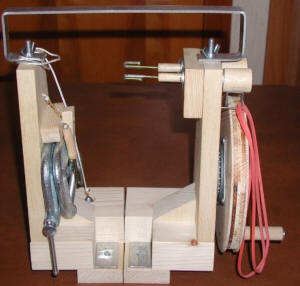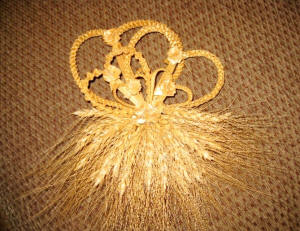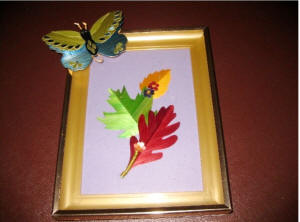|
 Wheat weaving is a skill that seems to have started in ancient Egypt
and is displayed in Egyptian tombs. Wheat weaving is a skill that seems to have started in ancient Egypt
and is displayed in Egyptian tombs.
Ruff has been doing wheat weaving for the past 35 years, ever since
attending her first wheat weaver’s convention. She said, “In 1987 my
mother encouraged me to go with her to the National Association of
Wheat Weavers Convention in Wichita, KS. At the convention they had
classes on some of the different ways to plait (fold) wheat straw
into different designs.” The ancient art of wheat weaving soon
became her hobby.
The US is divided into three districts with a different district
hosting the convention each year, so Ruff has traveled to several
different locations to attend these conventions. Ruff said, “I have
been to many cities for the conventions including San Francisco, San
Diego, Houston, Minneapolis, and Boston, among others. In the past
35 years, Ruff has only missed one convention.
Of all the conventions, Ruff says she probably enjoyed Boston most.
In Boston, Ruff said, "there is so much history there and the people
were especially friendly – always willing to help if we looked like
we were lost.”
Through the wheat weaving conventions, Ruff has met many people. She
loves going because she has made so many friends from around the
world over the years.

Among Ruff’s travels, Ruff and her parents went to Missenden,
England, a small town not far from London, in 1995. During that
time, Ruff said, “We stayed at the Abby there and took classes from
Master Wheat Weavers Veronica Main and Peter Shelley. In that class
they taught us how to make threads out of wheat straw.”
In 1997, Ruff was fortunate enough to be able to return to England
and take more classes. Through Ruff’s visits to England, she has
developed friendships with Main and Shelley, who have taught her so
much. Both Main and Shelley have been to conventions on several
occasions, visited the U.S. and stayed at the Ruff’s place. Ruff
considers them dear friends.
Those who Ruff has taken wheat weaving classes under come from
several different countries. Ruff has met and taken classes under
Nonie McFarland of Australia, Richard Kulbacki of Canada, Elaine
Lindsay from Scotland, Raisa Ramanena from Belarus and Atie
Nijenhuis-Britting from Holland.
In Ruff’s travels, a machine she saw while in England caught her
eye. She said, “I asked them if could take pictures of the machine
and measurements. They said yes, so I proceeded to get the
measurements I needed, brought it all home and told my husband, Don,
that I needed one!”

Ruff said, “Don built me one that worked perfectly. Since then, he
has made 110 machines and we have sold them all over the world. He
has machines in Canada, Australia, Holland, England, Belarus, Japan,
Mexico, and in many of the states.”
The Ruffs, who were childhood sweethearts have been
married for 55 years and Don has made many tools that help Dianne
with her wheat weaving. Besides building the machines, Don makes all
the tools needed for straw work, including a straw spinner.
[to top of second column] |

Associations that have been formed to preserve the
art and traditions of wheat weaving. The Illinois Association of
Wheat Weavers (IAWW) and National Association of Wheat Weavers (NAWW)
are two associations Ruff is a part of that promote the art of wheat
weaving. She is a member and current president of the IAWW, which is
dedicated to preserving the historic art of wheat weaving and
sharing the craft with future generations.
Ruff is a charter member and past president of the NAWW. NAWW is
dedicated to developing, promoting, educating and teaching
techniques of all forms of straw artistry to preserve the history
and traditions associated with the centuries’ old folk art of corn
dollies, wheat plaiting (wheat weaving), and other forms of straw
art.
Techniques used in wheat weaving
The art of wheat weaving can be done by various techniques including
plaiting, marquetry, Swiss straws, embroidery and tied straw.
The techniques Ruff shared in her presentation are described below:

Plaiting is the technique of folding and bending the straw
repetitively into plait or woven patterns. Many different plaits
were developed during the height of the straw hat industry.

Marquetry uses bits of flattened straw (sometimes dyed) to form
intricate appliqué patterns. During the Napoleonic war, prisoners
used straw from their bedding to create marquetry designs on items
to trade.
Swiss Straws uses whole straw, split straw, or spun straw threads to
create small decorative trimmings. Swiss straw was originally
developed in Switzerland over a period of 300 years for the fashion
industry to produce trimming for straw hats.

Embroidery used straw splits and spun straw threads to make
traditional embroidery stitches on cloth. Throughout history it has
been used to decorate clothing and items for use in churches.

Tied straw can be made into many shapes, which is done by tying
straws together. Over the centuries, straws from wheat, oats,
barley, rye and rice were used for making harvest tokens. Many of
these were tied together.
Through sharing these techniques, Ruff and others may be able to
ensure the ancient art form of wheat weaving continues to be
preserved for years to come.
[Angela Reiners] |